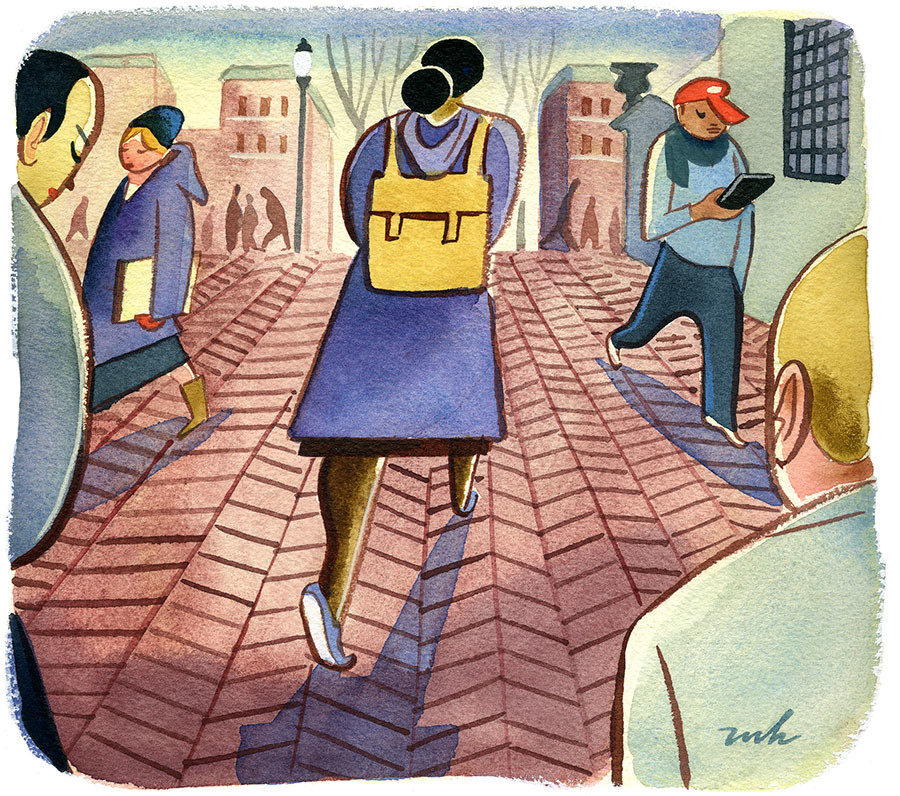To honor Columbia’s bicentennial in 1954, the City of New York gave the University an unusual gift: the one-block stretch of West 116th Street between Broadway and Amsterdam Avenue, which cut through the heart of the Morningside campus. Soon after, the street was closed to traffic and converted into a tree-lined public walkway. Two brick sidewalks, which dated to the opening of the campus in 1897, were preserved, while the roadway was repaved with hexagonal asphalt blocks, with wide strips of lawn added on either side. At the behest of alumni, the Board of Trustees named the 760-foot corridor College Walk.
The walkway became Columbia’s grand promenade and the central gathering place for protest and performance, carnivals and club fairs, Convocation and Commencement. World leaders have trod upon it, filmmakers have immortalized it, and lovers have proposed marriage on it. And every December, the trees on College Walk — littleleaf lindens and Japanese flowering cherries — are ceremonially strung with twinkling white lights that dazzle through the winter.
Though the asphalt path is widest, it’s the bricks that define the look of College Walk. According to Andrew Dolkart ’77GSAPP, a professor of historic preservation at Columbia and the author of Morningside Heights: A History of its Architecture and Development, the original Catskill bricks, named after their place of origin, were chosen by campus architect Charles McKim 1904HON to harmonize with the academic buildings, which were made of a type of dark-red brick known as Harvard brick. The sidewalk bricks, tidily arranged in a herringbone pattern, echo the motif on Low Plaza.
Over time, under the weight of the daily commerce of a major university, the central path began to sink. Dips and divots formed, and during rainstorms and snowmelts small puddles bloomed. In 2007 the University replaced the road’s old “hex blocks.” But the brick walkways were also sagging and collecting water, and while individual bricks were switched out through the years, the paths could become slick and sloshy in wet weather. Finally, this past summer, before the start of the academic year and the return of heavy foot traffic, Columbia Facilities embarked on a major renovation. Over the course of two months, the bricks of the southern span of College Walk were removed, and fresh bricks were set down.
The new paving bricks, made by the Pine Hall Brick Company in Winston-Salem, North Carolina, are sturdier than their predecessors. “They have more substance and traction and will eliminate slips and trips,” says Donald Schlosser, assistant vice president of campus operations. “Pedestrian safety is our top priority.” He estimates that more than 150,000 bricks were used. Beneath them lies a multilayered substrate of highly compacted concrete and asphalt — a far stronger foundation than what was there before — and a new drainage system to keep the route clear of puddles. “We built this like a roadway,” says Schlosser. “The bricks should remain nice and even and drain properly for years to come.”
The College Walk overhaul is the latest in a wave of similar projects that began in 2017 with Butler Plaza and the walkway leading from Butler to the Sundial. “We’re being strategic about moving forward through the campus,” Schlosser says. “The whole south end of the campus has been refurbished, and we want to keep going north.” For Schlosser, who has been guiding projects at Facilities since 2000, these brick-by-brick improvements are their own reward. “This campus is a jewel in the city of New York, and helping to make it more attractive is an honor,” he says. “You step off Broadway and you walk in and it’s just magnificent.”
This article appears in the Winter 2021-22 print edition of Columbia Magazine with the title "Another Brick in the Walk."



